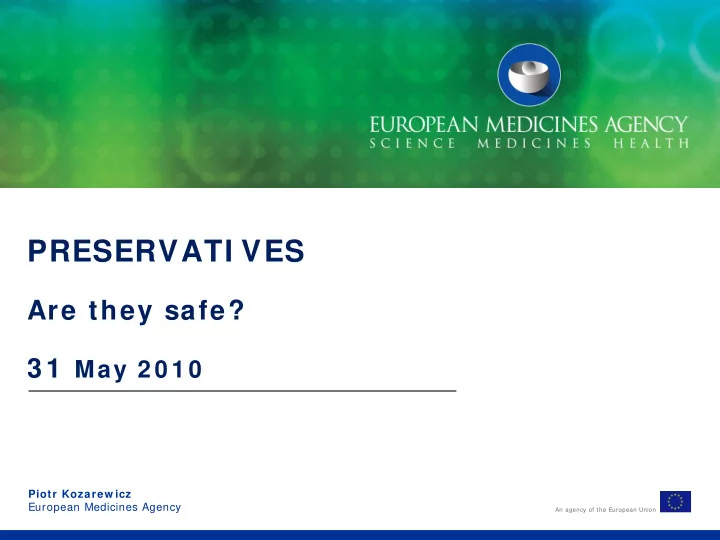

PRESERVATI VES Are they safe? 3 1 May 2 0 1 0 Piotr Kozarew icz European Medicines Agency An agency of the European Union
Key Principles - Excipients Most experts agree that formulations for the paediatric population may need to be different to those for adults: � Formulations should be as simple as possible � Number of excipients should be reduced to a minimum � No unnecessary additives � Excipient levels should be reduced to a minimum 2
Key Principles - Preservatives According to Guideline on Excipients in the Dossier for Application for Marketing Authorisation of a Medicinal Product (Doc. Ref. EMEA/ CHMP/ QW P/ 3 9 6 9 5 1 / 2 0 0 6 ): “Antimicrobial preservatives are normally added to prevent microbial proliferation arising under in use conditions. The properties are due to certain chemical groups which are usually harmful to living cells and might therefore be associated to certain risks when used in man.“ 3
Key Principles - Preservatives “Inclusion of antimicrobial preservatives or antioxidants in a finished product needs special justification. The use of these substances should be avoided in general, especially w hen considering the suitability of related form ulations to the paediatric population.” 4
Problem ? W e have the Guideline … so w hat is the problem ? 5
Problem w ith Preservatives Safety concerns? Are the accumulated safety data relevant to the paediatric population? Should we ban them in paediatric formulations? What about existing formulations? 6
Problem w ith Preservatives � Preservatives � May cause their own undesirable effects � They may be tolerated in adults but what about the paediatric population? � It is nearly always technically possible to re-think the product development to remove them or minimise their use 7
Policy m aking No sim ple answ er - difficult to deliver a single dogmatic view on the problem. Strong Negative position � Banned in ALL paediatric age groups? Or only in the Lower age groups e.g. neonates & infants? � Banned for Long-term continuous use only? Relaxed position � OK for older children – but how old? � For Short term use are we not concerned? 8
Safety of Preservatives � Look at EU Food Legislation as a possible indicator of long-term safety � Look at EU Food Safety Agency (EFSA) Scientific Committee Reports Example : Propyl paraben is not recommended in the food legislation. Provisional conclusion – parabens should not be used in paediatric medicines for long term use. An extreme position considering many medicines already on the EU market with parabens - but do we want to keep on repeating this? A worthy aim to keep in mind. 9
Safety of Preservatives Methyl & Ethyl parabens EFSA has assigned ADI of 10mg/ kg/ day Propyl paraben EFSA has not assigned an ADI Reports of developmental problems in juvenile animals. Failure of testicular development. Must be seen as relevant to paediatric use, esp. lower age groups. Optim al approach - propyl paraben should not be used in paediatric medicines for neonates, infants and small children. Not even in the short term. 10
Safety of Preservatives Other preservatives Benzoic acid and its salts Signals suggesting effect on activity and attention in children, however their relevance has not been evaluated nor confirmed. Currently approved for use as food additive. Sorbic acid and its salts Currently approved for use as food additive. 11
Preservatives in eye drops Ophthalm ic preparations without preservatives are strongly recom m ended for use in paediatric patients, especially neonates. Therefore, pharmaceutical companies should develop preparations without preservatives wherever possible in order to cater for the diversity of patients’ needs. Nevertheless, based on a review of available safety evidence, a general recommendation not to use preservatives in eye drops cannot be supported. EMEA Public Statement on Antimicrobial Preservatives in Ophthalmic Preparations for Human Use (Doc. Ref.: EMEA/ 622721/ 2009) 12
Current approach … � Preservative free formulations whenever possible should be considered. Instead of developing multidose liquid formulations requiring preservation alternatives such as solid dosage forms (granulates, granules in sachets, bulk granules in bottles with measuring devices, individual “dry” doses that can be converted to liquid immediately prior to use, etc) should be investigated 13
Current approach … � When preservatives are required, the concentration should be at the minimum level consistent with satisfactory antimicrobial function in each individual preparation and a thorough justification for the choice of the preservative should be provided. � Non-clinical and clinical studies of appropriate design and duration are needed to give reassurance that the proposed formulations are optimal in term of benefit/ risk balance. 14
Future … A lot of unanswered questions: We have to find a balance between a strong and relaxed position on formulation issues, keeping in mind: � The need to have high quality appropriate pharmaceutical formulations for a sensitive population with special needs � The “precautionary principle” � Benefit/ Risk arguments � The need to be consistent 15
Discussion … Thank you for the attention
Recommend
More recommend